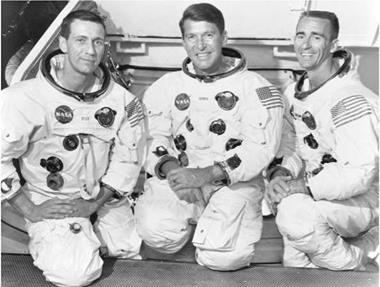A NATION IN MOURNING
Along with his crewmate Roger Chaffee, Gus Grissom was given a hero’s burial at Arlington National Cemetery, Virginia on 31 January 1967 in a service which was broadcast nationwide on television. That same day, Ed White was buried with full military honors in West Point’s Old Cemetery in Orange County, New York.
Their names are engraved on the Space Mirror Memorial at the Kennedy Space Center in Florida. At the request of the deceased astronauts’ families, the mission that never flew was named Apollo 1, and when Neil Armstrong and Buzz Aldrin landed on the Moon in July 1969 they took with them an Apollo 1 mission patch which they left there.
Just days before he died, Gus Grissom finished drafting his book Gemini: A Personal Account of Man’s Venture into Space. In it, he once again emphasized, “The conquest of space is worth the risk of life.”
Immediately after the disaster, an Apollo 204 Review Board was established by NASA and this published its findings in April 1967. The fire was attributed to an electrical fault within the cockpit. Exacerbating factors were the extensive use of flammable materials in the construction of the cockpit and in the astronauts’ space suits, plus the high-pressure pure oxygen atmosphere within the cabin. In response, NASA vastly reduced the amount of flammable materials and changed to a nitrogen-oxygen mixture in the cabin for ground testing through to launch. The agency also moved to a Block II command module design, the hatch of which could be opened far more easily and rapidly in the event of an emergency.
I asked former Mercury recovery helicopter pilot Jim Lewis where he was on the day of the Apollo pad fire, and for his reaction to the loss of Gus and the other two astronauts. “As I mentioned earlier, I was support team leader for Apollo 9, and we were conducting a closed hatch test on the Apollo 9 command module at the North American facility in Downey, California. The test was stopped, the hatch opened, and Jim McDivitt, the mission commander, was called away to the phone. He returned and told us what had happened. My reaction, and I think that of us all, was stunned, mistyeyed disbelief. Gus was one of the best and it just didn’t seem possible at the time that any such thing could have happened. I was subsequently assigned to the hatch redesign team led by Frank Borman. As I recall, that took about six months and most of it was spent at the Downey facility. Those were good days also because all of us went about that task with a vengeance to insure that kind of thing would be precluded in the future.”13
It took more than a year and a half before NASA was once again prepared to send astronauts into space, by which time the Apollo spacecraft had undergone extensive improvement. On 11 October 1968, Apollo 7, commanded by Gus Grissom’s friend Wally Schirra, completed 163 orbits of the Earth during an eleven-day mission in the redesigned command module.
Deke Slayton always argued that the first person on the Moon should have been one of the original Mercury astronauts, and that man he had determined was Virgil Ivan (‘Gus’) Grissom. In his autobiography Slayton wrote, “One thing that would probably have been different if Gus had lived: the first guy to walk on the Moon would have been Gus Grissom, not Neil Armstrong.”14
Norman Grissom is one who believes that his brother, had he lived, might have been selected as the first person to walk on the Moon. As he observed in 2000, “I think history has shown he was one of our outstanding people. He made a great contribution to the space race. Without him, I don’t think the space program would be where it’s at now.”15
|
The crew of Apollo 7: Donn Eisele, Wally Schirra and Walt Cunningham. (Photo: NASA) |
|
NASA astronaut Virgil (‘Gus’) Grissom. (Photo: NASA) |












